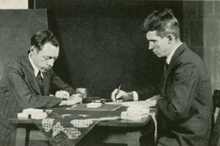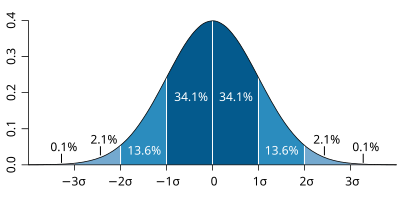

| Part of a series on the |
| Paranormal |
|---|
Zener cards are cards used to conduct experiments for extrasensory perception (ESP). Perceptual psychologist Karl Zener (1903–1964) designed the cards in the early 1930s for experiments conducted with his colleague, parapsychologist J. B. Rhine (1895–1980).[1][2]
Overview[edit]

The Zener cards are a deck of 25 cards, five of each symbol. The five symbols are: a hollow circle, a plus sign, three vertical wavy lines, a hollow square, and a hollow five-pointed star.[3]: 115 [4]
In a test for ESP, the experimenter picks up a card in a shuffled pack, observes the symbol, and records the answer of the person being tested, who would guess which of the five designs is on the card. The experimenter continues until all the cards in the pack are used.
Poor shuffling methods can make the order of cards in the deck easier to predict[5] and the cards could have been inadvertently or intentionally marked and manipulated.[6] In his experiments, J. B. Rhine first shuffled the cards by hand but later decided to use a machine for shuffling.[7]
In his book, The New Apocrypha, John Sladek expressed incredulity at the tests stating, "It's astonishing that playing cards should have been chosen for ESP research at all. They are, after all, the instrument of stage magicians and second-dealing gamblers; they can be marked and manipulated in many traditional ways. At the best of times, card-shuffling is a poor way of getting a random distribution of symbols."[6]
Rhine's experiments with Zener cards were discredited due either to sensory leakage or to cheating, or both. The latter included the subject being able to read the symbols from slight indentations on the backs of cards, and being able to both see and hear the experimenter, which allowed the subject to note facial expressions and breathing patterns.[8]
Terence Hines has written of the original experiments:
The methods the Rhines used to prevent subjects from gaining hints and clues as to the design on the cards were far from adequate. In many experiments, the cards were displayed face up, but hidden behind a small wooden shield. Several ways of obtaining information about the design on the card remain even in the presence of the shield. For instance, the subject may be able sometimes to see the design on the face-up card reflected in the agent’s glasses. Even if the agent isn’t wearing glasses it is possible to see the reflection in his cornea.[3]: 119
Once Rhine took precautions in response to criticisms of his methods, he was unable to find any high-scoring subjects.[9]
James Alcock notes, "Despite Rhine’s confidence that he had established the reality of extrasensory perception, he had not done so. Methodological problems with his experiments eventually came to light, and as a result parapsychologists no longer run card-guessing studies and rarely even refer to Rhine’s work."[10]
The chemist Irving Langmuir called Rhine's experiments an example of pathological science – the science of things that aren't so – and criticized its practitioners not as dishonest people but as ones that have sufficiently fooled themselves.[11]
During James Randi's TV special Exploring Psychic Powers Live! a psychic was tested on a deck of 250 Zener cards and was only able to predict 50 of them correctly, which is the expected result of random guessing the cards.[12]
In 2016 Massimo Polidoro tested an Italian mother and daughter that were claiming a 90% and above success rate of psychic transmission using Zener cards. Upon restricting them from seeing each other's faces and to the use of a silent writing method their success rate dropped to no better than chance. The women were cognizant of the fact that they required visual contact to achieve transmission of the symbols saying, "This kind of understanding is so natural to us, all this attention to us is also very surprising. There are no tricks, but surely we understand each other with looks. It always happens."[13]
In June 2023, a novel approach to the usage of Zener cards was suggested, employing artificial intelligence. OpenAI's language model, ChatGPT, was proposed as a way to simulate Zener card experiments.[14]
Statistics[edit]

The results of many tests using Zener cards fit with a typical normal distribution.
Probability predicts these test results for a test of 25 questions with five possible answers if chance is operating:
- 79% of people will get between 3 and 7 correct (probability is a more precise calculation).
- The probability of guessing 8 or more correctly is 10.9% (in a group of 25, you can expect several scores in this range by chance).
- Getting 15 out of 25 correct is about 1 in 90,000.
- Getting 20 out of 25 correct is about 1 in 5 billion.
- Getting all 25 correct has a probability of about 1 in 300 quadrillion.[15]
See also[edit]
References[edit]
- ^ Skeptical, a Handbook on Pseudoscience and the Paranormal. Canberra Skeptics. 1989. p. 28. ISBN 978-0731657940. Retrieved 14 December 2018.
- ^ "Zener Cards". Glossary of Skepticism & the Paranormal. About.com. Archived from the original on 1 September 2007. Retrieved 20 December 2006.
- ^ a b Hines, T. (2003). Pseudoscience and the Paranormal. Prometheus Books. ISBN 978-1573929790. Retrieved 18 May 2018.
- ^ Jarvis, Matt; Russell, Julia (2002). Key Ideas in Psychology. Nelson Thornes. p. 117. ISBN 0-7487-6564-6.
- ^ Carroll, Bob (17 February 2006). "Zener ESP Cards". The Skeptic's Dictionary. Retrieved 24 December 2023.
- ^ a b Sladek, J. T. (1973). The New Apocrypha: A Guide to Strange Science and Occult Beliefs. Hart-Davis, MacGibbon. p. 174. ISBN 978-0246107152. Retrieved 18 May 2018.
- ^ Pigliucci, Massimo (2010). Nonsense on Stilts: How to Tell Science From Bunk. University of Chicago Press. pp. 80–82. ISBN 978-0226667867. Retrieved 18 May 2018.
- ^ Smith, J. C. (2009). Pseudoscience and Extraordinary Claims of the Paranormal: A Critical Thinker's Toolkit. Wiley. ISBN 978-1444310139. Retrieved 18 May 2018.
- ^ Christopher, Milbourne (1971). ESP, Seers & Psychics. Crowell. ISBN 978-0690268157. Retrieved 18 May 2018.
- ^ Alcock, Jim (6 January 2011). "Back from the Future: Parapsychology and the Bem Affair". Skeptical Inquirer. Retrieved 24 December 2023.
- ^ Park, Robert L. (2002). Voodoo Science: The Road from Foolishness to Fraud. Oxford University Press. pp. 40–41. ISBN 978-0198604433. Retrieved 21 May 2018.
- ^ "Exploring psychic powers live [videorecording]". National Library of Australia. Retrieved 18 May 2018.
- ^ Polidoro, Massimo (October 2018). "A Telepathy Investigation". Skeptical Inquirer. 42 (5): 21–23. Retrieved 22 August 2018.
- ^ "Can AI read minds or communicate with us telepathically?". The Jasper Whisperer. Medium. Retrieved 26 June 2023.
- ^ Shermer, Michael (3 August 2011). "Deviations: A Skeptical Investigation of Edgar Cayce's Association for Research and Enlightenment". Skeptic.com. Retrieved 21 May 2018.